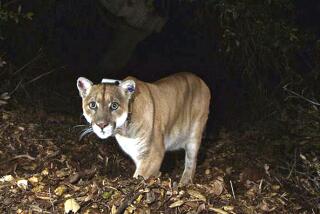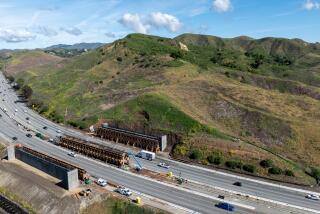Editorial: Why did the mountain lion cross the 405 Freeway?
The puma known as P-61 usually covers a wide swath of the Santa Monica Mountains, from Malibu Canyon to the Westside of L.A. But for several days in July, he only prowled up and down close to the edge of the 405 Freeway, roughly from the Skirball Center to the Getty.
The National Park Service scientists who monitor him by the signals from his GPS tracking collar were understandably intrigued. Rarely do pumas cross the 405. Even they seem to know it’s treacherous. A few have died trying. But on the morning of July 19, a researcher woke up and checked a night’s worth of GPS data: At 2 a.m., P-61 was on the west side of the freeway. At 4 a.m., he was on the east side. “Wow!!! Look at where P-61 is!” the researcher texted his colleagues.
Whether the 4-year-old puma sprinted across 10 lanes of freeway in the dead of night or — smarter and more likely — simply took Sepulveda Boulevard where it crosses under the freeway from the west side to the east, he accomplished something unusual. Almost none of the 75 big cats that have been collared, tracked and studied for the last 17 years have successfully crossed the 405. The one exception is the famous P-22 of Griffith Park, who probably crossed the 405 at some point — but before scientists collared and began tracking him. And it’s possible that some untracked pumas have managed to cross. In fact, scientists believe there is one such male lion living on the east side of the 405 where P-61 now is.
P-61 was successful, but the fact that such a crossing is so rare should serve as a reminder of the need for wildlife crossings to preserve the species in Southern California. The number of pumas, also known as mountain lions, in this region is so alarmingly low that wildlife and environmental advocates have petitioned the state to list them (along with those in Central California) as threatened. The fragmentation of their habitats from continuing urban development is one of the main reasons they are disappearing.
Between 2002 and the end of January 2018, researchers say, 18 pumas died on roads and freeways. Three died on Malibu Canyon Road. P-39 successfully crossed the 118 Freeway into the Simi Hills only to die crossing back a few days later in December 2016. Two of her kittens died crossing that same freeway in the following two months.
Millions of dollars have been spent to preserve open land in the Santa Monica Mountains and other ranges. If we want these pumas to survive and find new territory (and mates) in those habitats, we have to make it easier for them to cross freeways and other roads to get there.
Sometimes that involves setting up fencing along a freeway to discourage mountain lions from entering in dangerous places and guiding them instead to existing tunnels or underpasses. (Mountain lions are quick studies, scientists say.) A tunnel under the 118 between habitats in the San Fernando and Simi valleys offers a relatively safe crossing, but there needs to be fencing to funnel lions to the tunnel. National Park Service scientists are discussing with California Department of Transportation officials creating a crossing at Liberty Canyon over the 101 Freeway, west of the 405, where there is habitat.
All these pathways are necessary if we want mountain lions to survive. And we should. They’re not only a majestic reminder of a time when wildlife roamed abundantly but, as “apex predators,” they are also key players in the ecosystem, helping support healthy habitats for aquatic and land animals. Crossings are even more urgent since the Woolsey fire burned almost half of the Santa Monica Mountains, thereby making much of the area unsuitable as a lion habitat for the time being.
Meanwhile, the state needs to ban the second generation rodenticides that have proved lethal not just to vermin but to the animals that ingest them up the food chain, including mountain lions. Assembly Bill 1788, which would ban their use, is making its way up the legislative food chain. (A Senate committee hears it Monday.)
As for P-61, he appears to have explored as far east in the hills as Benedict Canyon. But now he’s back near the eastern edge of the 405. Perhaps he’s been pushed out of the territory by the male lion who was already there, or perhaps he’s just returning to his old territory. Either way, let’s hope he’s successful when he crosses back.
More to Read
A cure for the common opinion
Get thought-provoking perspectives with our weekly newsletter.
You may occasionally receive promotional content from the Los Angeles Times.










